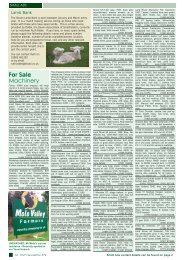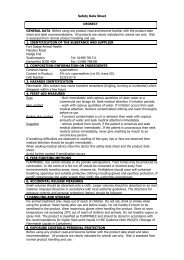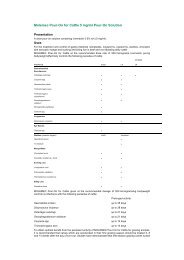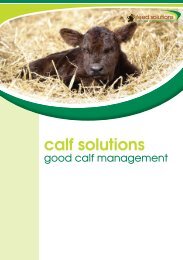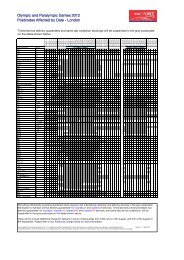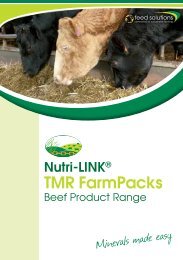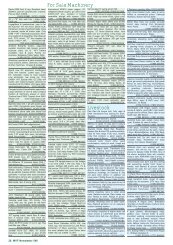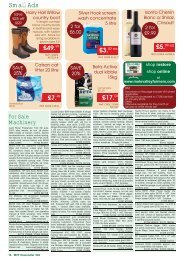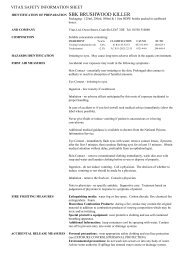MoleValley Calf - Mole Valley Farmers
MoleValley Calf - Mole Valley Farmers
MoleValley Calf - Mole Valley Farmers
You also want an ePaper? Increase the reach of your titles
YUMPU automatically turns print PDFs into web optimized ePapers that Google loves.
Coccidiosis in calves<br />
Coccidiosis has been recognised as a major<br />
cause of scouring and poor growth rates in<br />
calves. Sub-clinical coccidiosis is often an<br />
’invisible’ disease that can have a serious<br />
economic impact on calf production.<br />
Coccidiosis in calves causes intestinal<br />
damage, resulting in depressed growth and performance and<br />
greater susceptibility to other infections. Fortunately, where<br />
there is a known history of coccidial infection, outbreaks can be<br />
prevented with pro-active herd health planning.<br />
Coccidiosis in caused when cells in the lining of the animal’s gut<br />
become infected with a single-celled ‘parasite’, not a bacteria<br />
but a protozoa called Eimeria. Coccidiosis rapidly destroys the<br />
lining of the gut. An infected calf will shed millions of coccidial<br />
oocysts in its faeces, every day, meaning infection is spread easily<br />
when animals are stocked densely and the environment is heavily<br />
contaminated. Other calves contract the infection when they<br />
consume these oocysts from the environment.<br />
Many coccidial infections exist at a sub-clinical level, and so it is<br />
often not tested for. It is this ‘sub-clinical’ infection that can cause<br />
unnecessary and serious production loss.<br />
• Sub optimal weight gain<br />
• Dry rough coat<br />
• Poor appetite<br />
Patrick Traill MRCVS, MVF<br />
Veterinary Services Manager<br />
Reduced growth is the main sign of coccidiosis.<br />
Signs of clinical coccidial infection<br />
Anorexia<br />
Weakness<br />
Fever<br />
Diarrhoea<br />
Dehydration<br />
Calves that survive severe clinical coccidiosis may never fully<br />
recover and could end up as runts and remain in poor condition.<br />
Risk factors for coccidiosis<br />
Any factors that cause stress<br />
Mixed ages<br />
Crowding<br />
Poor ventilation<br />
Soiled bedding with warm environment<br />
Presence of calves that are infected and<br />
shedding cocci into the environment<br />
2012 CALF MANAGEMENT GUIDE | MOLE VALLEY FARMERS<br />
Diagnosis<br />
An analysis of faeces will confi rm presence of coccidial oocysts.<br />
Samples need to be collected from at least 10 animals and<br />
importantly not just those that are scouring, as peak oocystshedding<br />
often does not occur when diarrhoea is present.<br />
Appropriate treatment at an appropriate time can then be<br />
recommended, stopping any further losses.<br />
Treatment, control and prevention<br />
Where there is a history of coccidial infections, it is possible<br />
to calculate when an outbreak of coccidial scours is most<br />
likely to occur, and consequently the best time to administer<br />
preventative treatment.<br />
There are two types of preventative treatment for coccidiosis:<br />
1) An in-feed coccidiostat fed for 28 days, which stops further<br />
reproduction and growth of coccidia.<br />
2) An oral administration of a coccidiocide to destroy the<br />
coccidia and prevent the clinical signs of coccidiosis. This also<br />
signifi cantly reduces the levels of oocyst excreted, reducing<br />
the disease pressure and helping safeguard other calves from<br />
developing infection.<br />
Hygiene<br />
Health and welfare<br />
Coccidial oocysts are very persistent; existing for over a year<br />
they are able to withstand freezing temperatures and are<br />
resistant to many to the majority of disinfections. Where<br />
possible operate an ‘all-in all-out’ policy with effective cleaning<br />
and disinfection in between bunches.<br />
Isolate scouring calves to allow them to be treated effectively<br />
and to reduce risk of disease transmission to others in the group.<br />
Spotting infection early with a faecal egg count and reducing<br />
the infective burden and treating where necessary is key to<br />
controlling this important disease that impacts on growth and<br />
production.<br />
Ask at your local MVF Branch for a Faecal Collection Kit<br />
Call us on<br />
0844 272<br />
4900<br />
8.30am - 5.30pm<br />
5 days a week<br />
15




